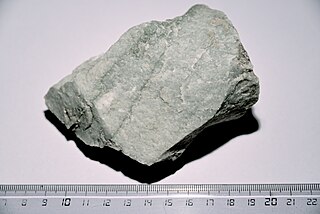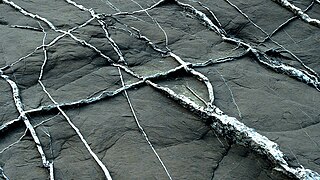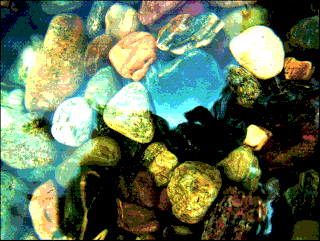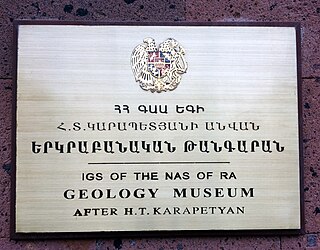
Sphalerite is a sulfide mineral with the chemical formula (Zn,Fe)S. It is the most important ore of zinc. Sphalerite is found in a variety of deposit types, but it is primarily in sedimentary exhalative, Mississippi-Valley type, and volcanogenic massive sulfide deposits. It is found in association with galena, chalcopyrite, pyrite, calcite, dolomite, quartz, rhodochrosite, and fluorite.
Sedimentology encompasses the study of modern sediments such as sand, silt, and clay, and the processes that result in their formation, transport, deposition and diagenesis. Sedimentologists apply their understanding of modern processes to interpret geologic history through observations of sedimentary rocks and sedimentary structures.

Rhodochrosite is a manganese carbonate mineral with chemical composition MnCO3. In its pure form (rare), it is typically a rose-red colour, but it can also be shades of pink to pale brown. It streaks white, and its Mohs hardness varies between 3.5 and 4.5. Its specific gravity is between 3.45 and 3.6. It crystallizes in the trigonal system, and cleaves with rhombohedral carbonate cleavage in three directions. Crystal twinning often is present. It is often confused with the manganese silicate, rhodonite, but is distinctly softer. Rhodochrosite is formed by the oxidation of manganese ore, and is found in South Africa, China, and the Americas. It is officially listed as one of the National symbols of Argentina.

Quartzite is a hard, non-foliated metamorphic rock which was originally pure quartz sandstone. Sandstone is converted into quartzite through heating and pressure usually related to tectonic compression within orogenic belts. Pure quartzite is usually white to grey, though quartzites often occur in various shades of pink and red due to varying amounts of hematite. Other colors, such as yellow, green, blue and orange, are due to other minerals.
Petrography is a branch of petrology that focuses on detailed descriptions of rocks. Someone who studies petrography is called a petrographer. The mineral content and the textural relationships within the rock are described in detail. The classification of rocks is based on the information acquired during the petrographic analysis. Petrographic descriptions start with the field notes at the outcrop and include macroscopic description of hand specimens. The most important petrographer's tool is the petrographic microscope. The detailed analysis of minerals by optical mineralogy in thin section and the micro-texture and structure are critical to understanding the origin of the rock.

In geology, a vein is a distinct sheetlike body of crystallized minerals within a rock. Veins form when mineral constituents carried by an aqueous solution within the rock mass are deposited through precipitation. The hydraulic flow involved is usually due to hydrothermal circulation.

In optical mineralogy and petrography, a thin section is a thin slice of a rock or mineral sample, prepared in a laboratory, for use with a polarizing petrographic microscope, electron microscope and electron microprobe. A thin sliver of rock is cut from the sample with a diamond saw and ground optically flat. It is then mounted on a glass slide and then ground smooth using progressively finer abrasive grit until the sample is only 30 μm thick. The method uses the Michel-Lévy interference colour chart to determine thickness, typically using quartz as the thickness gauge because it is one of the most abundant minerals.

Lahıc is a village and municipality on the southern slopes of Greater Caucasus within the Ismailli Rayon of Azerbaijan. Population is approximately 860 people who speak the Tat language, also known as Tati Persian, a Southwestern Iranian language spoken by the Tats of Azerbaijan and Russia.

Uranium ore deposits are economically recoverable concentrations of uranium within the Earth's crust. Uranium is one of the most common elements in the Earth's crust, being 40 times more common than silver and 500 times more common than gold. It can be found almost everywhere in rock, soil, rivers, and oceans. The challenge for commercial uranium extraction is to find those areas where the concentrations are adequate to form an economically viable deposit. The primary use for uranium obtained from mining is in fuel for nuclear reactors.

The Sterling Hill Mine, now known as the Sterling Hill Mining Museum, is a former zinc mine in Ogdensburg, Sussex County, New Jersey, United States. It was the last working underground mine in New Jersey when it closed in 1986, and it became a museum in 1989. Along with the nearby Franklin Mine, it is known for its variety of minerals, especially the fluorescent varieties. It was added to the National Register of Historic Places in 1991.

Mirali Seyidali oglu Qashqai, was an eminent Azerbaijani and Soviet geologist, author of multitude works in the sphere of geomorphology and stratigraphy. He was an honorary member of Mineralogical Society, former chairman of Azerbaijani department of the Society, and full member of the National Academy of Sciences of the Azerbaijan SSR. He was one of the founders of scientific school in the sphere geologo-mineralogical sciences and he was the supervisor of geochemistry and mineralogy of ore departments of Geology Institute of the National Academy of Sciences of Azerbaijan.

The Geological Museum of the State Geological Institute is a museum in Warsaw, Poland. The museum was established in 1919.

Roundness is the degree of smoothing due to abrasion of sedimentary particles. It is expressed as the ratio of the average radius of curvature of the edges or corners to the radius of curvature of the maximum inscribed sphere.

Museum of local history of Lahij village – was founded in 1985 and located in Lahıc village in Ismailli rayon of Azerbaijan. Aliyev Maarif Aghamehedi oglu is a main keeper of the museum.

Shebeke - are windows filled with coloured glass, created by Azerbaijani folk craftsmen from small wooden parts without glue and nails.
The Azerbaijan is a country with very favorable natural conditions and rich natural resources. Snowy peaks, high mountains, foothill fertile soils, wide plains, Lowest Land Points Below Ocean Level are the main landscape forms of republic. This complex landscape structure has caused the variety in natural conditions - climate, soil-vegetation, and water resources. This, in turn, led to the uneven distribution of population and farms on the territory, and the specialization of production on different types.

Geological Museum after H. Karapetyan of Institute of Geological Sciences of the National Academy of Sciences of Armenia is an academic scientific museum. It was founded in 1937 and reconstructed in 2012. The Museum has the following departments: Mineralogy, Paleontology, Petrography, Natural Resources, Mineral Waters in Armenia, Natural Monuments of Armenia.
Bilateral relations exist between Azerbaijan and Jordan. Cooperation between the countries is carried out in such areas as justice, tourism, defense, Information and communication technologies (ICT), transport, statistics, military affairs, standardization, emergency management, etc.

Rhinoceros binagadensis, sometimes called Dicerorhinus binagadensis, is an extinct species of rhinoceros that lived in the second half of the Last Glacial Period. The remains were discovered in 1938 at the Binagadi asphalt lake in the southeast of the Binagadi village, on the Absheron Peninsula of Azerbaijan.
Marif Seyid Babir ogly Zeynalov was a Candidate of sciences of Geology-Mineralogy, Honored scientist.















